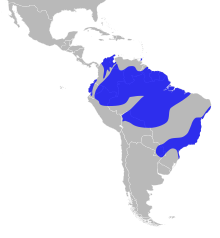White-bearded manakin
| White-bearded manakin | |
|---|---|
 |
|
| Male | |
 |
|
| Female in São Paulo, Brazil | |
| Scientific classification | |
| Kingdom: | Animalia |
| Phylum: | Chordata |
| Class: | Aves |
| Order: | Passeriformes |
| Family: | Pipridae |
| Genus: | Manacus |
| Species: | M. manacus |
| Binomial name | |
|
Manacus manacus (Linnaeus, 1766) |
|
 |
|
The white-bearded manakin (Manacus manacus) is a small passerine bird which breeds in tropical South America. It is found from Colombia, Venezuela and Trinidad south to Bolivia and northern Argentina. This manakin is found in forests, secondary growth and plantations. It is a small, plump bird about 10.7 centimetres (4.2 in) long. Males have a black crown, upper back, wings and tail and are otherwise white. Females are olive-green and resemble female golden-headed manakins. At breeding time, males are involved in lekking behaviour on the forest floor during which they puff out their neck feathers. This is a fairly common species with a wide range, and the International Union for Conservation of Nature has rated its conservation status as being of "least concern".
Like other manakins, the white-bearded manakin is a compact, brightly coloured forest bird, typically 10.7 centimetres (4.2 in) long and weighing 16.5 grams (0.58 oz). The adult male has a black crown, upper back, wings and tail, and the plumage is otherwise white. He has orange legs.
The female and young males are olive-green and resemble female golden-headed manakins, but they have orange legs. The race endemic to Trinidad, M. m. trinitatis is larger than mainland birds, and the female has yellower underparts. Apart from the buzzing display song, the white-bearded manakin has a number of other calls, including a trilled musical peeerr.
These manakins eat fruit and some insects.
The male white-bearded manakin has a fascinating breeding display at a communal lek. Each male clears a patch of forest floor to bare earth, and perches on a bare stick. The display consists of rapid leaps between sticks and the ground, accompanied by a loud wing snap, the whirring of the wings, and a chee-poo call. Groups of up to 70 birds may perform together, the largest leks being in Trinidad. The female builds a shallow cup nest low in a tree; two brown-mottled white eggs are laid, and incubated entirely by the female for about 18–19 days, with a further 13–15 days to fledging. The young are fed mainly on regurgitated fruit with some insects.
...
Wikipedia

